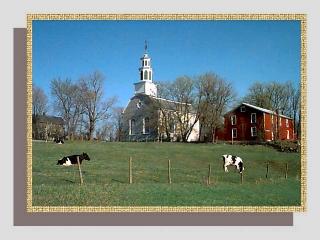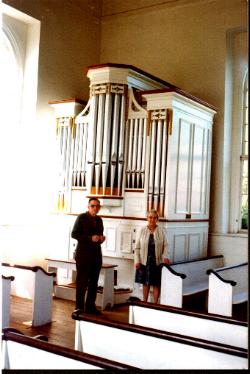Three Rivers
Hudson~Mohawk~Schoharie
History From America's Most Famous Valleys

Palatine
Church 1770. Photo by ajberry, Easter Sunday 1998.

Photo
of Mr. & Mrs. Robert Rowland by the free standing organ at Palatine Church,
by R. Truimpho. Used with permission.
Journal
by Richard
Truimpho
January
10, 1981
The
Palatine Dutch began farming the Mohawk Valley 80 years after the Pilgrims
came over on the Mayflower.
One
of their settlements sprang up near Fox's grist mill on Caroga Creek, a short
distance up stream from its confluence with the Mohawk River. The Palatines
were God-fearing folk; in the 1760's at the hamlet of Fox's Mill they quarried
limestone and built the Palatine church. It is said that General George Washington
once worshiped there.
Two
hundred years later the church has been restored by the Palatine Society,
whose members trace their lineage back to the early settlers. For many years,
the church was without an organ, the original having died of old age sometime
beyond living memory.
So
when Robert S. Rowland, the septuagenarian church organ builder, whose roots
sprung from the Mohawk Valley, was looking for some way to do something for
his old hometown, he conceived the idea of building a new organ for the Palatine
Church Shrine and donating it in memory of his parents.
Over
a period of several years, sandwiched in between his regular work of church
organ building and repair, he built the organ in his worship in the Hudson
Valley community of Ossining. He built it as a free-standing organ, patterned
after the pipe organs that were built in the American Colonies prior to and
immediately following the American Revolution by such men as David Tannenberg
and the four generations of Dieffenbachs.
Finally
in the spring of 1978 the organ was completed. Robert then dismantled the
organ and trucked it to the Mohawk Valley. During the summer, he and his
wife, Mildred, assembled the organ inside the Palatine Church; at the same
time they acted as curators because the church is open to the public during
the summer as a historical shrine.
Trying
to assemble an organ while answering questions from tourists can be frustrating
at times. Although he himself is a member of the Palatine Society, Robert
has no qualms about poking fun at those members who take themselves too
seriously.
On
one particularly hectic day when there were a lot of visitors, Robert became
somewhat annoyed at one persistent tourist.
"You
know the kind," he said, "an old biddy with a long nose, had her nose in everybody's
business, the kind that makes you like to look the other way, see?
"She
said, 'Wall, uh, what're you doing here anyway? Whooo are you? Our group are
all Palatines,' she said. 'We belong to the Palatine Society.
"Well,
of course, we do, too, but I didn't tell her that.
"She
says, 'Waall, what's your name?'
"Well,
I told her what my name was and she says, 'Are you one of those famous Palatines?'
"I
said, 'no, I don't happen to be one of those famous Palatines.'
"Waall,'
she says, 'where do you come from?'
"Well,
by that time I began to get kind of irritated, see? So I said, 'I'll tell
you, lady, where I come from. I said, this is a true story; you won't believe
this, but it's true.'
"Way
back in 1709 when Queen Anne was having trouble with these old Palatines...they
came over from the Palatinates, you know, settled in England, and she had
to get them out of the country because they had pigs, and chickens, and
goats and ducks, and geese, and lice, and everything else. She decided to
ship them over here to pick up tar and you know, pitch pine for the English
Navy.
"And
they landed in Rhinebeck and from Rhinebeck they came up the Schoharie and
arrived here. And she sent all those Palatines over on 10 boats, you know.
"'Oh,
yes,' she said. She knew all about that, she knew it all.
"'Well,'
I said, 'what you didn't know is that after the queen got them all shipped,
sifted them, you see, shoved them off shore, she had her scouts look all around
England to clean the country up. And they found a lot of these old vagabonds,
and tramps, and thieves, and ne'er do wells, and everything. They got them
all togehter and they found that they were all named Rowland.'
"So
they took all these old Rowlands and put them all together with all their
filth, and put them on another boat that they knew would never reach port,
unseaworthy you know, and shoved them off to follow up behind the Palatines.
"Now,
they weren't Palatines, they were Rowlands. So the Palatines kept looking
back and looking at each other, and they said, 'Here come those awful Rowlands
in that other boat.' Now they said to their children, 'When we land, don't'
you pay any attention to those old Rowlands because they've got more lice
than we have.'
"Well,
anyway, the Palatines finally landed here and they looked back, and no Rowlands.
'Hooray,' they thought, 'They've all drowned, boat and all.'
"'But
the Rowlands fooled them, and in a few years they started to sprout up all
over the country, and ,' I said, 'that's where I came from.'
"She
said, 'I-I-I-I think you're fooling me.'
"I
said, 'I'm not fooling you one bit, lady. That's the god's hones truth.'
I said, 'That's a true story.'
"She
said, 'THAT'S a true story?'
"I
said, 'That's a true story because I made it up. Absolutely true because I
made it up myself.'
"'Now
I know you're fooling,' she said, and left in a huff."
From
Bellows Pumper to Organ Builder
by RICHARD
TRIUMPHO
One of
the earliest memories of Robert S. Rowland Took Place in the Methodist Church
in St. Johnsville, NY., when he was a little boy attending the evening service
with his parents.
"I woke
up in the middle of the service and saw a man pumping a lever up and down in
a dark corner of the choir loft. I screamed because I though it might be the
devil himself."
The man
was merely pumping the bellows for the pipe organ, as Bobby discovered. Maybe
that incident marks the beginning of Rowland's career as church organ builder,
a career that has spanned half a century during which he has built more than
100 organs.
He has
constructed church organs in several northeastern states, but one of the most
engaging is in the same town where he first developed his love of organs.
A number
of years ago, at an age when many are enjoying retirement, Rowland became nostalgic
for the hometown of his boyhood and conceived the idea of donating an organ
to one of its churches. He learned that the venerable Palatine, church, a structure
dating from the American Revolution, had been without an organ since its original
instrument disintegrated.
For the
next dozen years, from 1965 to 1977, Rowland worked in his spare time building
the gift organ.
The free-standing
organ is designed to match the pipe organs that were built in the American Colonies
by such men as David Tannenberg and four generations of Dieffenbachs. It was
dedicated in 1978, with a recital by the builder's daughter, Roberta Raboldt.
As a child,
Rowland hovered around that organ in the St. Johnsville Methodist Church where
he first saw the bellows pumper.
Rowland
recalls: "It was an old tracker organ and I was fascinated by all the mechanical
parts that made it work. From the keyboard to the wind valves under the pipes
was a whole system of wires, squares, trackers, and roller boards to transmit
motion from the keys up into the valves themselves-by pressing, rolling and
twisting.
"Old Danny
Richards, the choir director, would say, 'Get out of here. You're in my way.'
"Then
one day when I was 11, Old Danny said, 'My boy, "I've got just the job for you,
pumping the organ. You get $12 a year, but you must watch the gauge carefully.'"
He was
referring to the air pressure gauge. Low pressure made the organ wheeze; too
high a pressure would blow the thing apart.
The pump
handle came through a slot in the wall, and in the dim recesses below the slot
was the bellows. Bob wanted to know what made the thing work.
I couldn't
peek through the slot while I was pumping the handle. One day my curiosity got
the better of me, so I stopped pumping for a few second and peeked.
"Of course,
the moment I stopped pumping, the air gauge fell to zero and the hymn the organist
was playing died with a whoosh."
Fortunately,
young Robert did not lose his job; Old Danny Richards gave him another chance.
From then on, his career with church organs was assured.
Rowland's
curiosity as to how things work led him to the Encyclopedia Britannica, where
he looked up a treatise on organ construction. He studied those pages for years
and read all he could about church organs in the village library.
While
he was still in grade school, he was constructing cardboard models of pipe organs.
In high school, he played the organ in the Methodist Church, and even did some
repairs-correcting a dropped key or tightening loose tracker parts.
In 1918,
when Robert Rowland was 20 years old, he had gained enough knowledge to rebuild
the old tracker organ in the Methodist Church. Later he installed an electric
blower to replace the bellows.
For the
next three years, he worked for two organ companies in Utica, N. Y., the C.
E. Morey Company and Buhl and Blaskfield Company. He also learned how to tune
an organ.
In 1921,
Rowland built his own organ shop in St. Johnsville-a 16 by 20 foot shed that
he used for the next 10 years. He recalls the very first organ he worked on
in that shop.
"It was
an old Beech organ, formerly in the st. Johnsville Reformed Church. It was moved
by horse and wagon to my shop where I rebuilt it and then installed it in the
Lutheran Church."
Rowland
built he first brand new organ in 1924 and installed it in St. Anthony's Church
in Herkimer, N.Y.
For the
next 50 years, his career as an organ builder flourished. Rowland has built
organs in numerous New York State communities, as well as Philadelphia, Pa.,
Adams, Mass., and Canaan, Conn. His work also can be found at Green Mountain
Junior College in Poultney, Vt., and in St. Anne's Chapel on the Redstone campus
of the University of Vermont at Burlington.
Rowland
is a member of the Organ Historical Society of America, an organization of organists,
organ builders, and devotees. He and his wife, Mildred, a retired schoolteacher,
now live in Ossining, N. Y.
At the
age of 83, he no longer builds organs, but still keeps active repairing and
tuning the church organs he has found fascinating for most of those years.
Copyright
© 1998, --
2003. Berry Enterprises. All rights reserved. All
items on the site are copyrighted. While
we welcome you to use the information provided on this web site by copying
it, or downloading it; this information is copyrighted
and not to be reproduced
for distribution, sale, or profit.